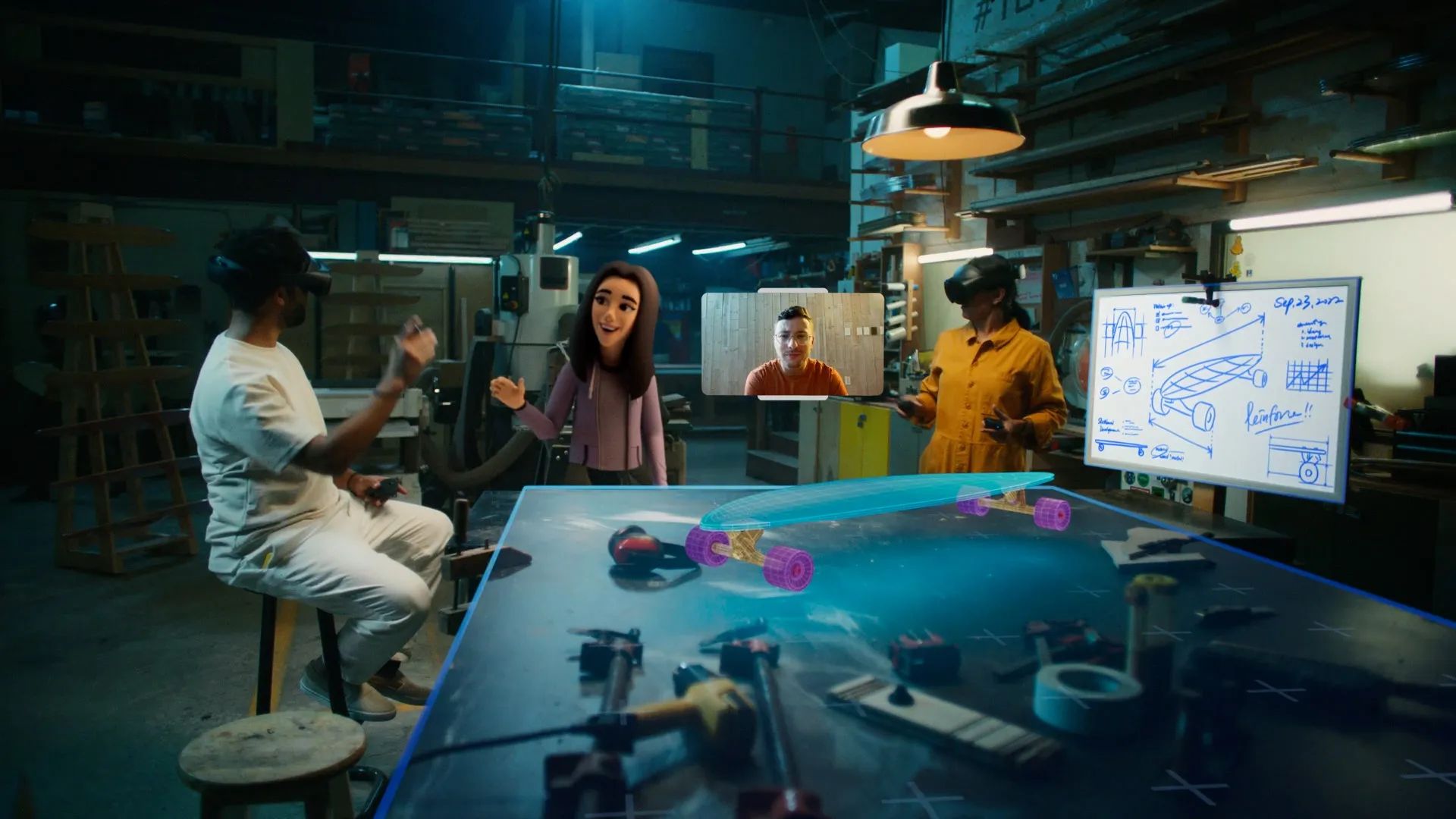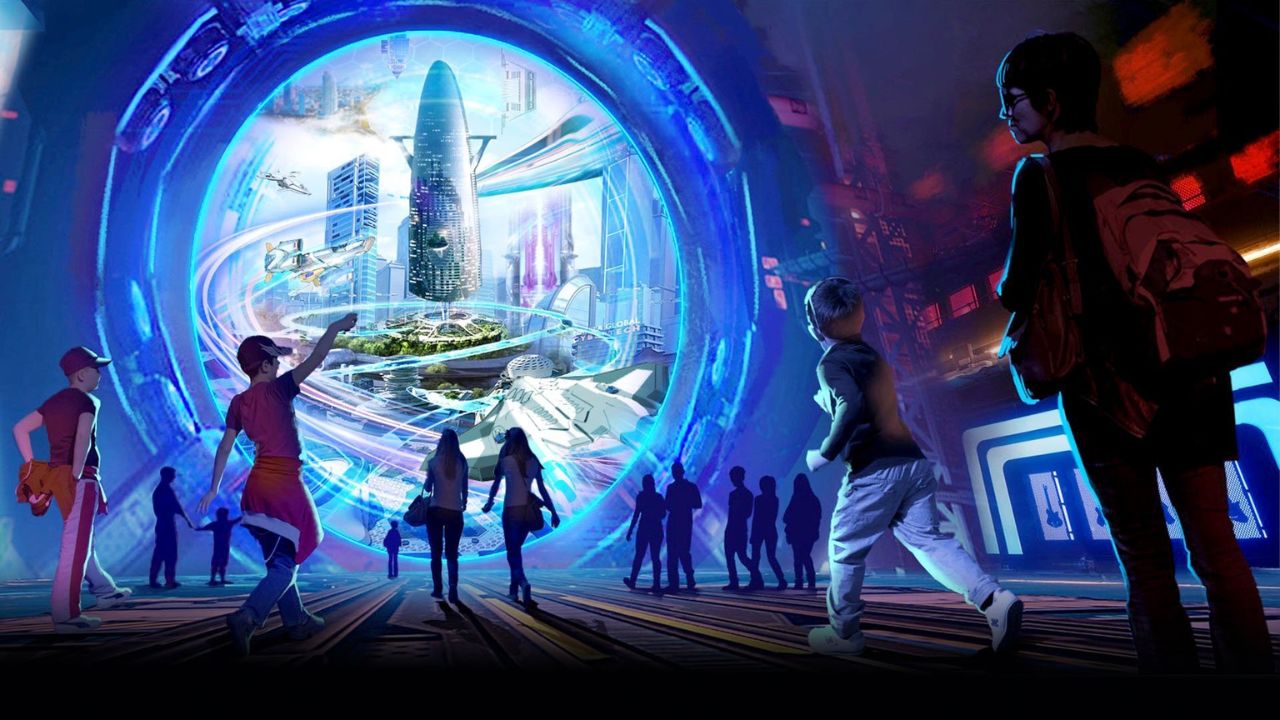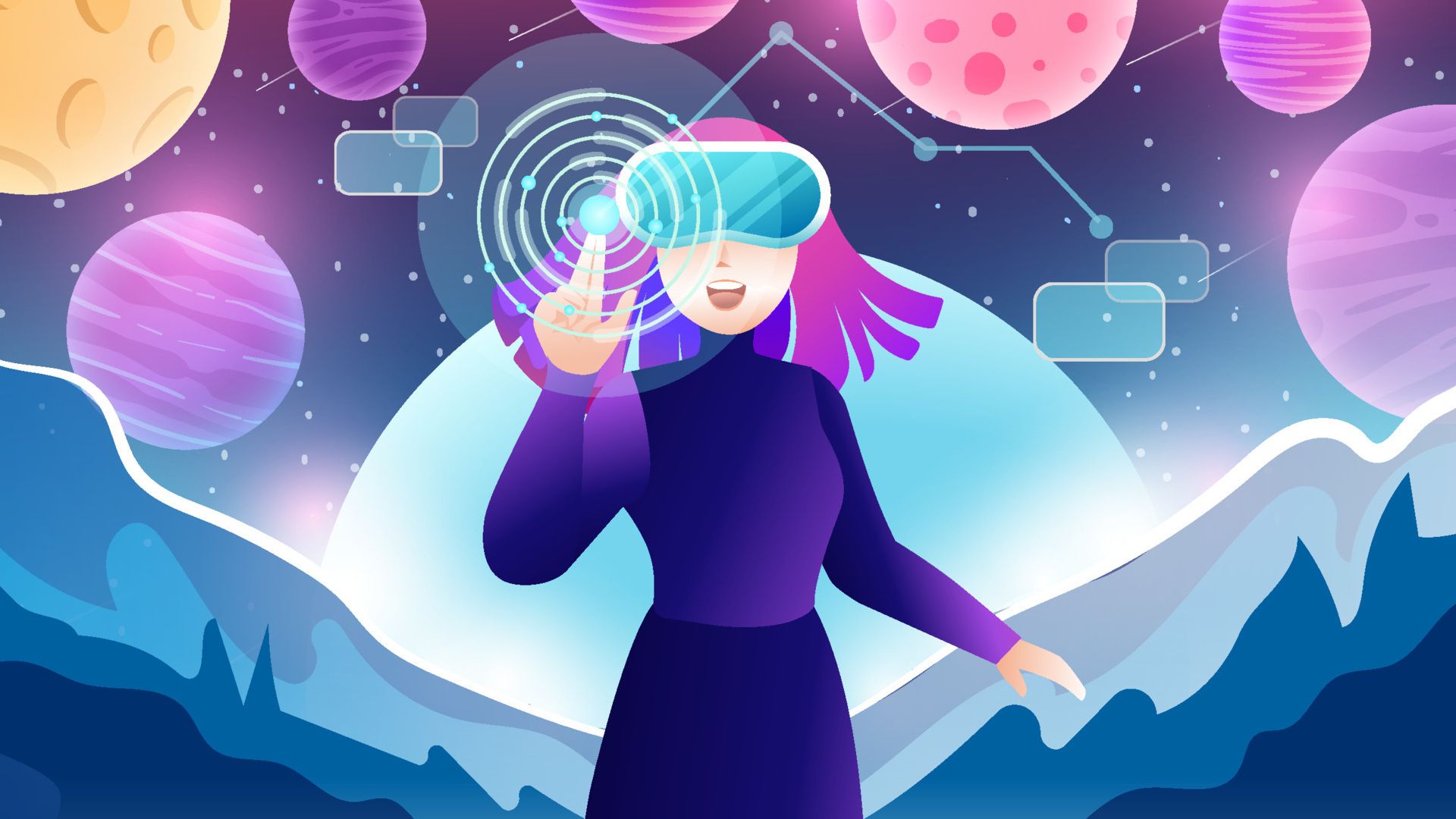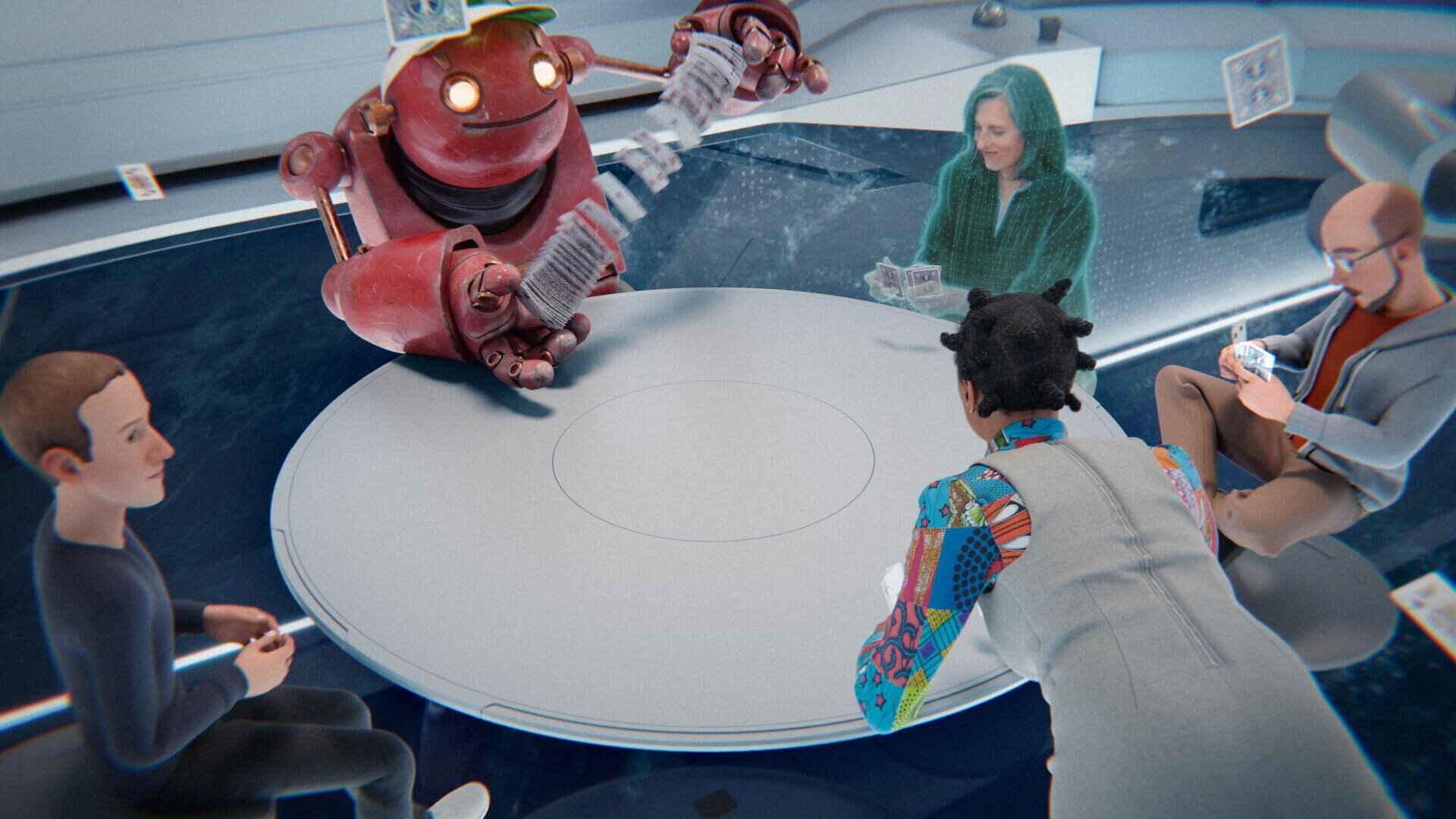Introduction
Welcome to the exciting world of the metaverse! In recent years, the concept of the metaverse has gained significant attention and has become a buzzword in the tech industry. This virtual realm promises to revolutionize the way we interact with digital content, bringing together elements of virtual reality (VR), augmented reality (AR), and other immersive technologies. The metaverse has the potential to reshape various aspects of our lives, from socializing and entertainment to education and business.
But what exactly is the metaverse? At its core, the metaverse is a collective virtual space where users can engage in a range of activities, interact with others, and access a vast array of digital content. It is a fully immersive and interactive world that goes beyond traditional 2D screens, enabling users to experience a sense of presence and agency in a virtual environment.
One crucial aspect of the metaverse is the integration of virtual reality (VR) and augmented reality (AR) technologies. VR allows users to enter completely immersive digital environments, while AR overlays virtual elements onto the real world. These technologies play a key role in creating the illusion of being present in a virtual world and enhance the overall user experience.
Metaverse platforms serve as the foundation for this interconnected virtual universe. These platforms provide the infrastructure and tools that enable users to explore, create, and interact with the metaverse. They offer a range of features, including virtual worlds, avatars, social networking capabilities, real-time communication, and content creation tools.
There are several key components that make up metaverse platforms. First and foremost are the virtual worlds, which can be expansive and diverse, ranging from digitally created landscapes to representations of real-world locations. These virtual worlds serve as the backdrop for various activities, such as gaming, socializing, shopping, and attending virtual events.
Another essential component is the use of avatars, which are virtual representations of users themselves. Avatars allow users to personalize their digital identity and interact with others in the metaverse. They can be customized in terms of appearance, clothing, and accessories, giving users a sense of individuality and self-expression.
Definition of the Metaverse
The term “metaverse” is derived from the combination of “meta,” meaning beyond or transcending, and “universe,” referring to a vast and interconnected system. While there is no universally accepted definition, the metaverse can be described as a collective virtual space that encompasses multiple interconnected digital worlds and allows users to engage with each other and the digital environment in a highly immersive manner.
Unlike traditional online platforms, the metaverse goes beyond simple websites or applications. It aims to create a seamless and immersive experience where users can interact not only with content but also with each other in real-time. It blurs the line between the physical and digital worlds, offering users a sense of presence and agency in a fully realized virtual environment.
In the metaverse, users can explore digital landscapes, socialize with other users, engage in various activities such as gaming or attending virtual events, and even create and monetize their own content. It is a continuously evolving and expanding universe that allows for limitless possibilities and experiences.
One of the defining features of the metaverse is its persistent nature. Unlike traditional virtual environments that reset every time a user logs out, the metaverse maintains a persistent state, meaning that changes made by users or events that occur within the virtual world persist even when users are not actively present. This creates a sense of continuity and shared experience for users.
The metaverse is not limited to a single platform or technology but is rather an overarching concept that encompasses various virtual reality (VR), augmented reality (AR), and other immersive technologies. It is an inclusive and interconnected ecosystem that brings together different platforms, devices, and applications to provide a cohesive and seamless user experience.
With the increasing advancements in technology and the growing interest in virtual and augmented reality, the metaverse is becoming a tangible reality. Major tech companies and startups alike are investing heavily in the development of metaverse platforms, aiming to create a digital universe that is accessible to users across different devices and locations.
In the next sections, we will explore the role of virtual reality (VR) and augmented reality (AR) in the metaverse, the key components of metaverse platforms, examples of existing metaverse platforms, and the potential applications and challenges associated with this exciting new frontier.
Role of Virtual Reality (VR) and Augmented Reality (AR)
Virtual reality (VR) and augmented reality (AR) play a crucial role in the development and realization of the metaverse. These immersive technologies provide the foundation for creating realistic and interactive virtual environments that users can explore and experience.
Virtual reality (VR) allows users to enter and interact with entirely computer-generated worlds. By wearing a VR headset, users are transported to a digital space where they can perceive and interact with virtual objects and environments as if they were physically present. This level of immersion creates a sense of presence, transporting users to a different reality altogether.
On the other hand, augmented reality (AR) overlays virtual content onto the real world. AR technologies use cameras and sensors to detect the user’s physical environment and superimpose digital elements, such as 3D objects or text, onto the real-world view displayed on a device screen. This blending of the digital and physical worlds enhances the user’s perception of reality and enables them to interact with virtual elements in their immediate surroundings.
Both VR and AR technologies are instrumental in creating a highly interactive and immersive metaverse. Users can explore virtual worlds, interact with virtual objects or characters, and even socialize with other users in a more intuitive and engaging manner.
In the metaverse, VR and AR technologies enable users to have a heightened sense of presence and agency. They can step into fantastical realms, participate in thrilling adventures, and engage in collaborative activities with others, all within a digital space that feels remarkably real.
Furthermore, VR and AR technologies foster new ways of content creation and consumption. Users can create and share their own virtual worlds, objects, or experiences, allowing for a decentralized and user-driven metaverse. With the rise of user-generated content, the metaverse becomes a dynamic and diverse ecosystem where creativity and innovation flourish.
Additionally, VR and AR have immense potential in various industries and sectors. From education and training to healthcare and entertainment, these technologies are revolutionizing how we learn, work, and entertain ourselves. The metaverse offers new opportunities for immersive learning experiences, remote collaboration, virtual tourism, and more, all made possible through the integration of VR and AR.
As VR and AR technologies continue to advance and become more accessible, the metaverse is poised to become a mainstream reality. With their ability to transport users to virtual worlds and bridge the gap between the physical and digital realms, VR and AR serve as the building blocks for a metaverse that captivates and engages users like never before.
Key Components of Metaverse Platforms
Metaverse platforms are the essential building blocks that enable the creation and operation of the metaverse. These platforms provide the infrastructure, tools, and features necessary for users to enter, explore, interact with, and create within the virtual universe. Let’s take a closer look at some of the key components of metaverse platforms:
Virtual Worlds:
Virtual worlds are the digital spaces within the metaverse where users can immerse themselves and engage in various activities. These worlds can range from beautifully rendered landscapes to replicas of real-world locations. They serve as the backdrop for social interactions, gaming experiences, virtual events, and more. Metaverse platforms provide users with access to a diverse range of virtual worlds to explore and experience.
Avatars:
Avatars are the digital representations of users within the metaverse. They allow individuals to customize their appearance, clothing, and accessories, giving them a unique digital identity. Avatars are instrumental in facilitating social interactions, enabling users to communicate, collaborate, and form connections with others in the metaverse. Metaverse platforms provide avatar creation tools and customization options to enhance personalization and self-expression.
Social Networking:
One of the core aspects of the metaverse is socialization. Metaverse platforms incorporate social networking capabilities to enable users to connect, communicate, and collaborate with each other. These platforms facilitate real-time interaction through chat, voice, and video features, allowing users to engage in conversations, form communities, and share experiences within the virtual realms.
Real-time Communication:
In addition to social networking, metaverse platforms also prioritize real-time communication. They provide users with the ability to communicate with others in a seamless and instantaneous manner, whether it be through audio chats, video calls, or text messaging. Real-time communication enhances the sense of presence and facilitates meaningful interactions within the metaverse.
Content Creation Tools:
Metaverse platforms offer a range of content creation tools that empower users to express their creativity and contribute to the metaverse. These tools allow users to design and build virtual objects, environments, and experiences. From building virtual homes and landscapes to designing custom avatars and creating interactive games, content creation tools play a vital role in shaping the metaverse and expanding its offerings.
Economy and Commerce:
Economic systems within metaverse platforms enable users to engage in virtual commerce, trade virtual goods and services, and even earn real or virtual currency. Metaverse platforms often incorporate marketplaces where users can buy and sell virtual assets, such as clothing, accessories, digital artworks, and more. The economy within the metaverse creates opportunities for entrepreneurship, creativity, and virtual entrepreneurship.
These key components together form the foundation of metaverse platforms, contributing to the creation of a vibrant, interconnected, and immersive virtual universe. Metaverse platforms continue to evolve, driven by technological advancements and user demands, bringing us closer to the vision of a fully-realized metaverse.
Examples of Metaverse Platforms
Several metaverse platforms have emerged in recent years, each offering unique features and experiences within the virtual universe. Let’s explore a few notable examples:
Roblox:
Roblox is a popular metaverse platform that allows users to create and play games, as well as socialize with others. It provides a vast catalog of user-generated games spanning various genres, from role-playing adventures to virtual simulations. Roblox boasts a vibrant community of developers and players, making it a thriving metaverse for gaming enthusiasts of all ages.
Second Life:
Second Life is one of the pioneering metaverse platforms that has been around for over a decade. It offers a virtual world where users can create unique avatars, explore diverse landscapes, participate in social activities and events, and even engage in virtual commerce. Second Life has a dedicated user base and fosters a vibrant community-driven metaverse experience.
Decentraland:
Decentraland is a metaverse platform built on blockchain technology, providing users with true ownership of virtual land and assets. It allows users to create and monetize their content, including 3D scenes, artifacts, and experiences. Decentraland incorporates a decentralized economy, where users can buy, sell, and trade virtual land and other digital assets using cryptocurrency.
Fortnite:
While primarily known as a popular battle royale game, Fortnite has also demonstrated metaverse-like qualities. The game features a constantly evolving virtual world, with live in-game events and collaborations with popular brands and artists. Fortnite’s virtual concerts, in particular, have garnered significant attention, showcasing the potential for immersive social experiences within a game-based metaverse.
Rec Room:
Rec Room is a virtual reality-based metaverse platform that emphasizes social interactions and activities. Users can create their virtual spaces, participate in multiplayer games, engage in virtual events, and connect with others in a playful and interactive environment. Rec Room’s cross-platform compatibility enables users to interact not only in VR but also on traditional screens, fostering inclusivity within the metaverse.
These examples represent just a fraction of the metaverse platforms that exist today. Each platform offers its unique blend of features, content, and community, catering to different audiences and interests. As the metaverse continues to evolve, we can expect to see more platforms emerge, each pushing the boundaries of interactivity, creativity, and socialization within the virtual universe.
Differences Between Metaverse Platforms
While all metaverse platforms share the overarching goal of creating immersive virtual experiences, there are notable differences in their features, focus, and user experiences. Here are some key points of divergence between metaverse platforms:
Focus and Purpose:
Metaverse platforms can vary significantly in terms of their primary focus. Some platforms are primarily gaming-centric, offering a wide range of gaming experiences within their virtual worlds. Others prioritize social interactions and community-building, providing a space for users to connect with like-minded individuals and engage in social activities. Understanding the primary focus of a metaverse platform helps users find the experience that aligns with their interests.
Virtual World Design:
The design and aesthetics of virtual worlds differ from one platform to another. Some platforms focus on creating highly realistic and visually stunning virtual environments, while others may adopt a more stylized or abstract art style. The diversity in virtual world design allows users to choose the aesthetic and atmosphere that resonates with their preferences and desired experiences within the metaverse.
Accessibility and Platform Compatibility:
Metaverse platforms may have different accessibility and platform compatibility requirements. Some platforms are accessible across a wide range of devices, including VR headsets, PCs, consoles, and mobile devices. Others may have more specific hardware or software requirements, limiting accessibility to certain devices or platforms. Understanding the accessibility and compatibility of a metaverse platform helps users determine the level of investment required to participate.
Content Creation Tools:
The level of content creation tools and capabilities available within metaverse platforms can vary. Some platforms provide robust and user-friendly content creation tools that allow users to build virtual worlds, objects, and experiences. Others may have more limited or specialized content creation options. Platforms with extensive content creation tools empower users to engage in more immersive and creative experiences within the metaverse.
Economy and Monetization:
The economic systems and monetization models also differ among metaverse platforms. Some platforms have their in-platform economies where users can buy, sell, and trade virtual goods or services using virtual currencies. Others may incorporate blockchain technology to enable true ownership and decentralized trading of virtual assets. Understanding the economy and monetization models of a metaverse platform helps users determine the potential for economic participation and investment.
These differences contribute to the diversity and richness of the metaverse ecosystem, offering users a range of choices based on their preferences, interests, and goals. Exploring and understanding these differences help users find the metaverse platforms that align with their desired experiences and enable them to fully immerse themselves in the virtual universe.
Potential Applications of Metaverse Platforms
The emergence of metaverse platforms opens up a world of possibilities across various industries and sectors. Here are some potential applications of metaverse platforms:
Education and Training:
Metaverse platforms have the potential to revolutionize education and training by providing immersive and interactive learning experiences. Virtual classrooms, simulations, and collaborative environments within the metaverse can enhance engagement, facilitate practical learning, and enable remote and flexible education opportunities. Students can explore historical sites, perform virtual experiments, and participate in realistic training scenarios, all within a virtual environment.
Socializing and Entertainment:
The metaverse offers new avenues for socializing and entertainment. Users can connect with friends, family, and people from all over the world within virtual spaces, attend live concerts, explore virtual art galleries, or participate in multiplayer games. The metaverse provides a platform for experiencing entertainment in novel and engaging ways, bridging the gap between physical and digital realms.
E-Commerce and Retail:
Metaverse platforms can revolutionize e-commerce and retail experiences by creating virtual storefronts and immersive shopping experiences. Users can explore virtual malls or marketplaces, try on virtual clothing or accessories on their personalized avatars, and make purchases within the metaverse. Virtual reality and augmented reality technologies can enhance the online shopping experience, enabling users to visualize products in a virtual environment before making a purchase.
Real Estate and Architecture:
Metaverse platforms can serve as a platform for virtual real estate and architectural experiences. Users can tour virtual properties, visualize architectural designs in 3D, and even collaborate with architects and designers in real-time. This offers a cost-effective and efficient way to showcase and experience real estate projects before they are constructed, as well as facilitate remote collaboration within the architectural and construction industries.
Healthcare and Therapy:
The metaverse has potential applications in healthcare and therapy. Virtual reality therapy can help individuals with phobias, anxiety, or PTSD by creating controlled and immersive environments for exposure therapy. Virtual medical simulations can provide training for medical professionals in performing surgeries or handling medical emergencies. The metaverse can also offer virtual support groups and mental health services, providing a safe and accessible space for therapy and counseling.
Virtual Events and Conferences:
The metaverse can transform the way we attend events and conferences. Virtual venues within metaverse platforms can host conferences, exhibitions, and virtual trade shows, eliminating the limitations of physical space and travel. Attendees can network, participate in panel discussions, and access information and resources within the virtual environment. This offers a flexible and inclusive way to engage in professional events and conferences while reducing the environmental impact.
These are just a few of the potential applications of metaverse platforms across various industries and sectors. As technology advances and metaverse platforms continue to evolve, we can expect to see innovative and transformative uses of the metaverse in areas that we haven’t even envisioned yet.
Challenges and Concerns with Metaverse Platforms
While metaverse platforms hold great promise, there are several challenges and concerns that need to be addressed for their successful development and widespread adoption. Here are some key considerations:
Accessibility and Inclusivity:
One of the primary challenges is ensuring that metaverse platforms are accessible and inclusive to a wide range of users. The cost of entry, especially for virtual reality (VR) hardware, can be a significant barrier for many individuals. Additionally, considerations such as accessibility for people with disabilities and providing support for multiple languages and cultures are crucial in ensuring equal participation and representation within the metaverse.
Data Privacy and Security:
As metaverse platforms collect and store vast amounts of user data, issues related to data privacy and security become paramount. Ensuring mechanisms for secure data handling, consent-based data sharing, and protecting users’ personal information from unauthorized access are crucial aspects of metaverse platform development. It is vital to establish robust privacy policies and transparent data practices to build trust within the metaverse community.
Content Moderation and Safety:
With user-generated content playing a significant role in metaverse platforms, ensuring proper content moderation and safety is essential. Platforms need to implement effective moderation systems to prevent harmful, offensive, or inappropriate content from being shared within the metaverse. Ensuring the safety of users, especially vulnerable populations such as children, is of utmost importance to create a positive and inclusive metaverse experience.
Ethical Use and Impact:
The ethical use and impact of metaverse platforms raise important questions, such as the potential for addiction, the impact on mental health and well-being, and the influence of advertising and commercialization within virtual spaces. Designing metaverse experiences that prioritize user well-being and implementing ethical guidelines that prevent exploitation or harm is a crucial consideration for platform developers and stakeholders.
Interoperability and Standards:
Metaverse platforms need to address interoperability and the establishment of common standards to create a more seamless and interconnected virtual universe. Standardizing protocols, formats, and compatibility between different platforms can enhance user experiences, facilitate cross-platform interactions, and encourage collaboration and innovation within the metaverse ecosystem.
Digital Divide and Equity:
The digital divide refers to the gap between those who have access to technology and those who do not. In order to fully realize the potential of the metaverse, addressing the digital divide and ensuring equitable access to metaverse platforms and technology is essential. Bridging this gap can help prevent the exacerbation of existing inequalities and create an inclusive metaverse experience for all individuals.
Addressing these challenges and concerns requires collaboration and cooperation between platform developers, industry stakeholders, policymakers, and user communities. By proactively addressing these issues, the metaverse can develop into a more inclusive, secure, and ethical virtual universe that benefits all participants.
Conclusion
The concept of the metaverse represents an exciting new frontier in the world of technology and digital experiences. With the integration of virtual reality (VR), augmented reality (AR), and other immersive technologies, metaverse platforms offer a unique opportunity to create interconnected virtual spaces where users can explore, interact, and create in unprecedented ways.
From gaming and socializing to education and commerce, the metaverse has the potential to revolutionize various industries and sectors. It enables immersive learning experiences, fosters social connections across geographical boundaries, transforms online shopping, and even facilitates virtual real estate experiences. The possibilities are vast and diverse.
However, as metaverse platforms continue to evolve, it is important to address the challenges and concerns associated with this emerging technology. Ensuring accessibility and inclusivity, safeguarding data privacy and security, implementing content moderation, and considering the ethical impact of these platforms are crucial aspects of their development and adoption.
Additionally, promoting interoperability, addressing the digital divide, and striving for equitable access are essential to create a metaverse that is accessible and beneficial for all individuals, regardless of their backgrounds or resources.
The journey towards a fully-realized metaverse requires collaboration, innovation, and a thoughtful approach. Developers, industry stakeholders, policymakers, and users must work together to build a metaverse that reflects the values of inclusivity, safety, and ethical use. By doing so, we can unlock the true potential of the metaverse and embrace the limitless opportunities it offers.
The metaverse is an ever-expanding and dynamic universe, continuously evolving and reshaping the way we interact with digital content. As technology continues to advance and our understanding of the metaverse deepens, it will undoubtedly become an integral part of our lives, further blurring the boundaries between the physical and digital worlds.
Embrace the metaverse, and get ready to explore a virtual universe where imagination knows no bounds.

























